Zovirax
Zovirax dosages: 800 mg, 400 mg, 200 mg
Zovirax packs: 30 pills, 60 pills, 90 pills, 120 pills, 180 pills, 270 pills, 360 pills
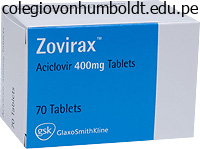
Buy discount zovirax 200mg line
Currently around one in 4 patients struggling a spinal-related peri-operative cardiac arrest is likely to endure a poor consequence. When a patient has deranged clotting for any cause the danger of epidural haematoma will increase. Block failure � if potential discuss with an anaesthetist and be ready to begin a unique analgesic plan. It is value getting an anaesthetist involved in discussions with the affected person from the beginning. Hypotension � most central neuraxial block induces a sympathetic block (one or two dermatomal ranges greater than the measured sensory level), which can result in peripheral vasodilatation. This requires emergency assessment to exclude the potential for epidural haematoma. Chapter 4: Local anaesthetics 55 Supraclavicular block Can be used for anaesthesia or post-operative analgesia Most typically used for orthopaedic, plastic and vascular surgical procedure Needle inserted behind the subclavian artery simply above the primary rib Most incessantly performed with ultrasound steerage within the awake affected person, allowing the operator to block C8 and T1 components that had been typically missed previously Useful for surgery to the elbow, forearm and hand Block dense sufficient to enable the awake patient to tolerate using a tourniquet Ipsilateral diaphragmatic paresis in as a lot as 40% of patients Serious problems include harm to vertebral artery, intravascular injection of local anaesthetic, pneumothorax. Both techniques permit catheters to be sited subsequent to the plexus, and a steady infusion of native anaesthetic. Tunnelling the catheter helps to prevent this and likewise reduces the infection threat. Other higher limb blocks Infra-clavicular blocking is technically difficult owing to the depth of the nerves across the axillary artery but the risk of diaphragmatic paresis is decreased and it provides a decrease probability of catheter migration if one is being used. The axillary brachial plexus block (performed in the axilla across the axillary artery) blocks four peripheral nerves (musculocutaneous, radial, median and ulnar nerves). The patient is unlikely to tolerate an upper limb tourniquet and would require a supplemental block. All the major nerves of the arm (radial, median and ulnar) can be blocked individually at a wide selection of locations in the higher and lower arm, either as rescue blocks for failed plexus analgesia or as discrete blocks combined with basic anaesthesia. Lower limb blocks the lower limb differs from the upper limb principally as a end result of it has two plexi supplying predominantly the ventral (lumbar plexus) and dorsal (sacral plexus) features of the limb. This makes it tougher to block the lower limb for awake surgical procedure utilizing peripheral nerve blockade as two injections might be needed. For awake surgery on the lower limb � spinal anaesthesia is normally the first-choice approach. Lumbar plexus blockade Useful for any surgical procedure involving the femur Targets the L2, L3 and L4 nerve roots as they form the femoral, lateral cutaneous nerve of leg and obturator nerve inside the body of psoas muscle Commonly performed using a peripheral nerve stimulator (although increasingly some operators use ultrasound to information some features of the block) Reputation for elevated dangers of issues, notably when utilizing landmarks technique and high volumes of native anaesthetic. Using a nerve stimulator and 56 Section I: Basic sciences smaller quantity injections of local anaesthetic (or using catheter techniques) may mitigate these risks. Femoral nerve blocks Useful for surgical procedure involving the femur Needle inserted in the groin Commonly performed with ultrasound guidance Were most frequently used for major knee surgical procedure however are becoming used much less regularly with the introduction of enhanced restoration programmes that have a concentrate on early mobilisation Modified low-dose femoral nerve blocks are utilized in some centres. Use a long-acting drug (experimentally, liposomal-encased medication offer the prospect of blocks lasting for days). Truncal blocks Intercostal blocks Used to block the T6 to T11 dermatomes Provide wound analgesia, however are much less reliable for deep pain (autonomic innervation) Chapter 4: Local anaesthetics fifty seven Useful for open cholecystectomy, thoracotamy. Mid-line wounds require bilateral blocks Needle inserted on the lower margin of selected ribs in the mid-axillary line and injecting 3�4 ml of local anaesthetic is injected close to the neurovascular bundle; Complications embody pneumothorax, injury to the neurovascular bundle and rapid uptake of local anaesthetic into the systemic circulation. Summary Local anaesthetic methods can be utilized to provide anaesthesia (awake surgery) and really efficient peri-operative analgesia with little or no systemic unwanted effects in appropriate patients. Opiate-sparing analgesic techniques function prominently in enhanced restoration programmes. An understanding of the pharmacology, use and issues of native anaesthetics will help the surgeon to be safe and assured in their practice. Cardiac arrest following regional anesthesia with etidocaine or bupivacaine Anesthesiology 1979; 51: 285�7. Acute and nonacute issues related to interscalene block and shoulder surgical procedure: potential study: a prospective examine. Regional anesthesia within the patient receiving antithrombotic or 58 Section I: Basic sciences thrombolytic therapy. Epidural anaesthesia and analgesia and consequence of major surgical procedure: a randomised trial.
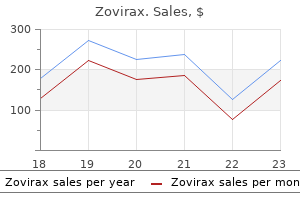
Buy cheap zovirax online
Treatment, which consists of antihistamines, moisturizing pores and skin preparations, ultraviolet mild, lidocaine infusions is usually unsatisfactory. Bacteremia and cellulitis brought on by pores and skin flora also are seen, particularly in sufferers with dialysis catheters. Staphylococcus aureus nasal carriage, which is frequent in dialysis patients, appears to be a risk issue for systemic staphylococcal infections. Nasal mupirocin ointment utilized periodically (five days in every month) might scale back staphylococcal carriage and infections. Coagulase-negative staphylococci are also a frequent explanation for catheter-related infections. However, chills and fever during hemodialysis can also end result from endotoxin formation by Gramnegative bacterial an infection contaminating the dialysate. Sterilization of dialysate sources and machines and periodic dialysate cultures are part of the routine maintenance program in hemodialysis models. Hemolysis from defective dialysis procedure can occur throughout or a while after a hemodialysis session and should trigger fatal hyperkalemia. Its causes, all preventable, include overheating of the dialysate, low solute focus in the dialysate, contamination of the dialysate with bleach, chloramine, nitrates, or different contaminants, and improper adjustment of the curler pump used with the arterial line. Free hemoglobin in the blood of the venous line is detected by a hemolysis monitor, which units off an alarm and shuts down the pump. Bleeding develops throughout hemodialysis both externally (around the dialysis needles, or from accidental disconnection of the dialysis lines), or internally, in affiliation with heparinization. Dialysis sufferers are significantly at risk to bleed from the gastrointestinal tract (often from angiodysplasia of the bowel wall), the retroperitoneal space, renal cysts, and intracranial websites, especially after falls and head trauma. It ought to be borne in mind that even a trivial trauma, which must be in any other case insignificant, may lead to a subdural hematoma in dialysis patients. Hypoglycemia, both spontaneous or after insulin administration, is widespread in dialysis patients. If no glucose is added to the dialysate, diabetics with poor glycemic control are topic to life-threatening hypoglycemia during hemodialysis. Addition of glucose to the dialysate, in a concentration of eleven mmol/L, reduces the frequency and severity of hypoglycemia throughout hemodialysis. While hypokalemia is rare before hemodialysis, serum potassium focus is round 2. This transient postdialysis hypokalemia has no opposed results, except in sufferers receiving digitalis preparations and people with severe heart illness, who require greater potassium concentrations within the dialysate. Patients with massive deficits in body potassium can develop hypokalemia throughout hemodialysis, even when dialysate potassium concentration is excessive. Complement activation may lead to modifications in leukocytes and to subsequent interactions between leukocytes and endothelial cells. In this occasion, blood neutrophil count decreases precipitously in the first jiffy of hemodialysis, and leukocyte aggregations produce a number of microemboli in lung Technique, Practice and Complications of Hemodialysis 401 capillaries. The main manifestation of complement activation by the dialysis membrane is hypoxemia. Hypoxemia throughout hemodialysis, nevertheless, could additionally be attributable to several different causes including hypoventilation secondary to lack of carbon dioxide within the dialyzer and probably the primary use syndrome. The first use syndrome consists either of an anaphylactic reaction with dyspnea, angioedema, urticaria, gastrointestinal cramps, wheezing and, in superior circumstances, cardiac arrest, or of milder nonspecific reactions with chest and again ache. IgE antibodies in opposition to proteins altered by ethylene oxide, which is used to sterilize the dialyzers, are discovered in many sufferers with anaphylaxis. The administration of anaphylaxis consists of immediate discontinuation of dialysis, corticosteroids, antihistamines, epinephrine and cardiac help measures. Dysrhythmias are widespread in patients with heart illness, particularly during and immediately after hemodialysis. Cardiac arrests during hemodialysis classes may be caused both by organic coronary heart illness The second class is frequent throughout hemodialysis and explains the relatively excessive probability of survival (approximately forty percent) after cardiopulmonary resuscitation within the dialysis unit. A low ldl cholesterol food plan high in polyunsaturated fatty acids, supplemented by lipid-lowering agents, could also be helpful. Hyperlipidemia is, most likely, the major pathogenetic mechanism of the accelerated atherosclerosis which develops in some dialysis sufferers.

Purchase zovirax with visa
Further research is required to set up specific remedy guidelines for using probiotics in the pediatric population. Since 1975, the World Health the majority of acute diarrheal sickness will resolve with supportive care and with out sequelae. Judicious use of antibiotic therapy is important since viruses trigger most episodes of acute diarrhea. Given that 40% of youngsters younger than 5 years old are hospitalized due to a rotavirus-related diarrheal episode, rotavirus vaccines are broadly recommended by pediatricians across Canada, Europe, and the United States. An organized and multifaceted strategy to diarrhea prevention, analysis, and remedy is required to improve the morbidity and mortality of children worldwide. Pediatric Gastrointestinal Disease: Pathophysiology, Diagnosis, Management, 2nd edn. Pigmented nevi of the oral mucosa: a clinicopathological examine of 36 new cases and evaluation of a hundred and fifty five cases from the literature. Evidence for the function of extremely leukotoxic Actinobacillus actinomycetemcomitans in the pathogenesis of localized juvenile and other types of early-onset periodontitis. Oral manifestations related to leukocyte adhesion deficiency: a five 12 months case examine. Heterotopic gastric mucosa of the esophagus: literature evaluate and proposal of clinicopathologic classification. Denouement and dialogue: congenital esophageal duplication cyst as a rare explanation for neonatal progressive stridor. Efficacy and safety of lansoprazole in adolescents with symptomatic erosive and non-erosive gastroesophageal reflux illness. Prevalence of endoscopic findings of erosive esophagitis in children: a populationbased examine. A international, evidence-based consensus on the definition of gastroesophageal reflux illness in the pediatric population. Efficacy of proton-pump inhibitors in youngsters with gastroesophageal reflux disease: a scientific review. A case-control research of sociodemographic and geographic characteristics of 335 kids with eosinophilic esophagitis. Eosinophilic esophagitis in kids and adults: a systematic evaluate and consensus recommendations for analysis and remedy. Identification of particular meals liable for irritation in kids with eosinophilic esophagitis efficiently treated with empiric elimination food regimen. Eosinophilic esophagitis: a prevalent disease in the United States that affects all age groups. Eosinophilic esophagitis: Updated consensus suggestions for youngsters and adults. Reviews in primary and clinical gastroenterology: biology and remedy of eosinophilic esophagitis. Reslizumab in kids and adolescents with eosinophilic esophagitis: outcomes of a double-blind, randomized, placebocontrolled trial. Chicago classification standards of esophageal motility issues defined in excessive resolution esophageal pressure topography. High-resolution manometry and impedance-pH/ manometry: useful tools in scientific and investigational esophagology. New applied sciences within the gastrointestinal clinic and research: impedance and highresolution manometry. Clinical and laboratory predictors of esophageal varices in children and adolescents with portal hypertension syndrome. Should youngsters with esophageal varices receive beta-blockers for the primary prevention of variceal hemorrhage Primary prophylaxis of variceal hemorrhage in kids with portal hypertension: a framework for future research. Prospective study of endoscopic esophageal variceal ligation utilizing a multiband ligator. Pharmacology and metabolism of anidulafungin, caspofungin, and micafungin in the remedy of invasive candidosis: review of the literature. Nongastroesophageal reflux disease-related infectious, inflammatory, and injurious issues of the esophagus. Glucagon use for esophageal coin dislodgement in youngsters: a potential double-blind, placebo-controlled trial. Chronic esophageal overseas our bodies in pediatric patients: a retrospective Recommended Reading 509 evaluation.

Purchase zovirax pills in toronto
The latter method is barely more sensitive than the differential washout method, with a reported sensitivity o�90% (20). Imaging at 20 minutes and then at 2 hours helps differentiate between the glandular tissues primarily based on how rapidly the radlotracer clears over time. A parathyroid adenoma sometimes demonstrates a spotlight of increased exercise that persists even at 2 hours after injection. This abnormality must be diagnosed shortly after start as a result of failure to promptly begin substitute therapy adversely impacts intellectual development. Hypothyroidism assodated with ectopic thyroid tissue happens sporadically, whereas hypothyroidism from biosynthetic defects is inherited (21). Screening for hypothyroidism is routine in newborns because failure to diagnose hypothyroidism may lead to severe intellectual impairment. Right renal cortical activity retention is signiftcant, and excretion of radiopharmaceutical into the accumulating system is minimal. The irregular response of the right kidney to captopril administration is also demonstrated on a time-activity curve of the renogram. CaptoprU, an inhibitor of angiotensin-converting enzyme, prevents efferent arteriole constriction. Scintigraphically, this difference is seen as delayed radiotracer uptake and cortical retention (23). The most couunon causes of renal hypoperfusion are atherosclerosis and fibromuscular dysplasia. After captopril administration, delayed radiotracer uptake and cortical retention are seen in the affected kidney. Hyperacute rejection would look comparable, though this prognosis is often made within the working room. In hyperacute rejection, preformed antibodies attack the transplanted kidney, inflicting vascular compromise and inhibiting circulate to the kidney. Rather, a photopenic area (arrow) is visualized inside the right anterior iliac fossa where the renal transplant is presumably located. Patients can present with a multitude of nonspedfic findings, together with pleuritic chest ache, hemoptysis, dyspnea, hypoxia, and tachypnea. Radiographic evaluation is commonly nonspecific, with findings together with a traditional chest, atelectasis, and small pleural effusion. Stress may be produced mechanically, such as via train or by pharmacologic means Areas of ischemia demonstrate a area of relatively decreased exercise on poststress images, which improves on relaxation and redistribution photographs. Nonreversible abnormalities represent areas of acute or remote myocardial infarction. A third sample of abnormal activity, often recognized as reverse redistribution (more frequent with thallium), seems as comparatively diminished exercise on relaxation or redistribution images and regular on stress images. The cause of reverse redistribution is unknown, but this discovering might correlate with myocardial ischemia in some patients. Some cardiac lesions can produce constructive stress checks within the absence of coronary artery illness. These lesions embody mitral valve prolapse, valvular aortic stenosis, aortic regurgitation, left bundle branch blo~ idiopathic hypertrophic subaortlc stenosis, cardiomyopathy, and hypertensive myocardial hypertrophy. Spedftc areas of artifact embody the apex with aortic regurgitation and the septum with left bundle branch block. In idiopathic hypertrophic subaortic stenosis and hypertensive myocardial hypertrophy, increased count density within the region of the septum produces a relative lower in the lateral wall, which may be mistaken for infarction (28). Its extraction fraction is lower than that of the other brokers; however, myocardial uptake is analogous. There can be much less complete radiation dose to the affected person with these brokers compared with 201Tl-chlortde. Radioisotope 201Tl-chloride is a potassium analog that localizes by active transport across the cell membrane. Its distribution outcomes from preliminary myocardial uptake and subsequent equilibration with the blood pool.
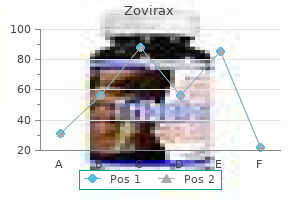
Order 200mg zovirax
The need for X-rays during the process have to be taken under consideration when choosing an operating table and positioning the affected person. Often complex positions are used with sufferers elevated up high or turned susceptible where airway, venous and different entry may be extra complicated. Care should be taken to guarantee these risks are managed prior to prepping and draping the affected person, when it becomes far more difficult. Chapter 19: Orthopaedic instances 229 Intra-operative administration Blood loss Pre-operative haemoglobin can be optimised and blood can be grouped and saved or crossmatched to permit rapid access if blood merchandise are needed. Tranexamic acid can be used routinely to minimise blood loss in decrease limb joint replacement surgery (its use is contra-indicated in sufferers with a personal historical past of thromboembolic illness and a few centres keep away from utilizing it in sufferers with coronary stents). Infection management Whenever surgical implants are used, it has been proven that prophylactic antibiotics can cut back the danger of an infection. The antibiotic should have reached peak tissue concentration on the time of the incision. The exact pharmacological agent used is commonly decided by local coverage, but it goes to be effective towards gram-positive organisms such as Staphylococcus aureus. It is usually accepted that many cephalosporins are contraindicated in sufferers over the age of sixty due to the chance of creating Clostridium difficile infections. Common hip surgery circumstances the hip is amongst the most common anatomic sites for surgical procedure, significantly in children, the retired and the elderly. In retired sufferers the surgery is most frequently elective hip alternative surgical procedure and within the aged urgent hip fracture surgical procedure. This remains a topic of national curiosity with present multicentre studies set up to try to present therapeutic recommendations. Hip fracture sufferers anticoagulated with warfarin ought to be given vitamin K until contra-indicated. It should be given six hours after surgery and continue for 28 days until contra-indicated. Mechanical prophylaxis with graduated compression stockings and foot or calf pumps should also be considered. Both hip fracture patients and elective hip substitute sufferers ought to receive prophylactic antibiotics. There is also a sign for the utilization of tranexamic acid, particularly in hip arthoplasty. In hip arthroplasty, bone cement is commonly pressurised contained in the intramedullary canal to secure the prosthesis. There is the chance that emboli or possibly a reaction to the cement might trigger a systemic impact that may, in uncommon circumstances, be deadly. Adequate cleansing and preparation of the canal could assist to keep away from this and in very fragile sufferers overpressurisation of the cement must be averted. In sure types of hip fracture a long Chapter 19: Orthopaedic cases 231 intramedullary femoral nail could additionally be wanted and this will likely contain reaming the intramedullary canal. This can result in the complication of fat emboli and the respiratory compromise that follows. Instrumenting and, specifically, reaming of the intramedullary canal should be averted in aged frail sufferers except no different is available. Where hip fractures are pathological, secondary to a quantity of femoral metastases, consideration must be given to venting the femur distal when instrumenting the canal to keep away from systemic emboli. Elective hip surgical procedure offers the benefit of allowing a complete pre-operative assessment. Particular attention is paid to the state of the pores and skin on the affected limb, on the lookout for signs of infection or energetic psoriatic plaques. Liaison with any related specialties can be carried out depending on the co-morbidities. As mentioned above, a key component of the pre-operative evaluation is the mental preparation of the affected person for surgical procedure. Enhanced recovery programmes for joint substitute have seen a excessive level of patient satisfaction and have resulted in considerably reducing the average size of stay after hip replacement. The specific type of anaesthetic chosen for hip substitute ought to goal to minimise post-operative nausea and pain, however leave motor function intact to allow day of operation mobilisation every time attainable. Elastomeric pumps with steady intra-articular infusion of low-dose local anaesthetic could contribute to efficient multimodal post-operative pain aid after hip alternative and have the possible benefit of lowering morphine consumption. Common knee, foot and ankle surgery circumstances One unique factor of working on the knee, foot and ankle areas is the widespread use of a tourniquet.
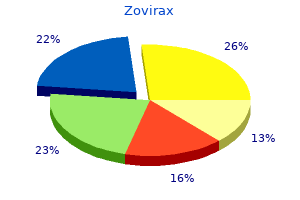
Discount 400 mg zovirax visa
Recurrent Stone Formers the increased chance of relapse during medical therapy makes the a quantity of stone former a candidate for comprehensive evaluation. Also, if limited evaluation exhibits presence of a threat factor or presence of active disease (recurrent stone, enlargement of stone, passage of stone gravel in the urine), a complete analysis should be done. In recurrent stone formers, full analysis detects metabolic abnormalities in ninety six % of patients. In addition to the studies suggested for limited analysis, the comprehensive analysis contains 24hour urine studies (preferably on 3 totally different occasions) to detect presence of supersaturation of stone forming ions within the urine. Urine volume, calcium, phosphate, uric acid, oxalate, citrate, cystine, magnesium, sodium, and creatinine must be measured. Bone density should be checked within the presence of hypercalcemia or hypercalciuria. Normal values of 24-hour urine excretion of varied ions are introduced in Table 5. Treatment of Risk Factors General measures to lower the concentration of urine, and reduce the excretion of stone forming ions must be taken in all stone formers. Further treatment of stone disease ought to be individualized primarily based upon the findings of evaluation. Specific measures might result in cure, corresponding to in these with primary hyperparathyroidism. General Measures Dietary Modification A low urine quantity is the first risk factor for stone formation. In a population primarily based research, a small increase of 250 ml in 24-hour urine output was associated with decrease fee of recurrence. A study of increased fluid intake in first time calcium stone formers additionally confirmed a decrease in recurrence within the intervention group. The fee of recurrence was 27 % for ordinary fluid consumption patients, and 12 percent for the intervention group. It is advisable to suggest consuming sufficient liquids to produce two liters of urine per day. Since brief intervals of concentrated urine can still lead to recurrence, it is essential to maintain urine dilute at all times. This requires water intake during the night and during times of physical exertion. Lemonade, with its excessive citrate content material could also be a preferable liquid, however related caloric intake could limit consumption of large quantities. Grapefruit juice intake was related to an elevated threat of kidney stones in the Nurses Health Study. Intake of colas, in all probability because of their phosphoric acid content and low pH, has been related to elevated risk of stone recurrence. Urinary Stones 387 Animal protein intake and high sodium intake are inclined to enhance calcium excretion in urine and should be restricted. A recent five-year trial of males with hypercalciuria and recurrent calcium oxalate stones showed a forty nine percent discount in recurrence with a food plan regular in calcium and low in animal protein and salt. However, the function of calcium dietary supplements is unclear and should be used with caution. Hypocitraturia Citrate binds to calcium and reduces supersaturation of calcium oxalate. Supplementation with citrate can lower recurrence, even in those with thiazide resistant stones. Hyperuricosuria Uric acid is a product of purine catabolism and can result from excessive protein intake, often identified as purine gluttony. Systemic diseases such as gout and myeloproliferative illnesses with high cell turnover may end up in excessive uric acid ranges and uricosuria, which promotes formation of calcium and uric acid stones. Hereditary circumstances (hypoxanthine guanine phosphoribosyltransferase deficiency, glycogen storage illness and excessive exercise of glutathione reductase) can also result in hyperuricosuria.
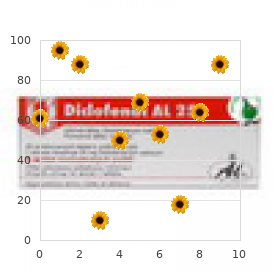
Buy zovirax with amex
The persistent pulsations of subarachnoid fiuid prevent therapeutic of the fracture fragments and produce a smooth-edged gradually widening fracture line. Clinically, the patient has a pulsatile soft-tissue mass on the website of the defect (54). Doppler sonography could additionally be used to follow the hemodynamic adjustments after embolization therapy (55,56). Doppler evaluation of the mass demonstrates the lesion to be vascular with arteriovenous shunting. Congestive failure and cardiomegaly within the new child should suggest the analysis, particularly in an toddler with a cranial bruit. High-output congestive failure in a new child with a cranial bruit is extremely suggestive of a vein of Galen aneurysm. Doppler sonography is diagnostic of the vascular malto decide the precise vascular anatomy previous to endovascular embolization. Frequent associations embrace dorsal midline cysts (30%) and Dandy-Walker malformations (57,58). This echogenidty must be differentiated from the traditional perlventricular blush of the perlventricular white matter. Between 2 and three weeks after the ischemic insult, cystic degeneration occurs, and the elevated echogenidty is replaced by numerous Swiss cheese-like cysts. With time and the event of testicular edema, the torsed testis enlarges and becomes hypoechoic. A whirlpool sign of the twisted spermatic wire has been described in literature (46). There are two forms of torsion-intravaginal and extravaginal, with intravaginal being the extra widespread. E:x:ttavaginal torsion happens in utero secondary to poor fixation and subsequent twisting of the spermatic cord within the inguinal canal. Therefore, at start, the neonate has a swollen, discolored scrotum, and the affected testis is incessantly already necrotic. Intravaginal torsion, common in adolescents and younger adults, is caused by an embryologic failure of fixation of the testicle to the tunica vaginalls the "bell-clapper" deformity), which permits the testicle to rotate freely on the vascular pedicle throughout the scrotal sac. The baby with acute scrotal pain constitutes a medical emergency, as delay in surgical intervention reduces the likelihood of testicular salvage. If the torsed testicle is detorsed within 6 hours of symptom onset, practically one hundred pc are viable. However, if torsion persists for greater than 24 hours, seldom is a testis salvageable. Color Doppler sonography is the imaging modality of option to consider the acute scrotum. The colour Doppler findings of torsion are diminished or absent testicular move on the affected aspect. In late or missed torsion, 1here is elevated peritesticular move across the avascular testis producing a rim signal. Although esophageal compression could produce symptoms, respiratory findings, including distress, wheezing, or stridor, predominate. Displacement or indentations on the trachea may be seen, or there could additionally be full loss of the tracheal air column on frontal projection, as in this case. The upper indentation is produced by the right-sided arch and the lower indentation by the left-sided arch. In most circumstances (80%), the proper arch is higher, bigger, and more posterior than the smaller anterior left arch. These patients are probably to have severe respiratory distress and bilateral air trapping. In addition to full tracheal rings, the pulmonary sling is commonly assodated with other congenital anomalies, including congenital coronary heart disease (this affected person also had complete anomalous pulmonary venous return) and gastrointestinal anomalies, similar to tracheoesophageal fistula. The actual numeric measurements are much less necessary than the overall appearance of the musculature and real-time statement of a persistently thickened and elongated pyloric channel. Using these positional maneuvers usually obviates the need for extra fluid or for placement of a nasogastric tube to decompress the stomach. Treatment is surgical with a Ramstedt pyloromyotomy by which the hypertrophied muscle is split longitudinally down to the level of the mucosa. Hypertrophy and hyperplasia of the round and longitudinal musculature of the pylorus trigger a gastric outlet obstruction resulting in the most common presentation, progressive, nonbilious vomiting in an toddler 2 to eight weeks of age.
References
- Gershenwald JE, Scolyer RA, Hess KR, et al. Melanoma staging: evidence-based changes in the American Joint Committee on Cancer eighth edition cancer staging manual. CA Cancer J Clin 2017;67(6):472-492.
- Perry, CP, Hantes, JM. Diagnosis and Laparoscopic Repair of Type I Obturator Hernia in Women With Chronic Neuralgic Pain JSLS. 2005 Apr-Jun; 9(2): 138-141.
- Patra J, Tatlor B, Irving H, et al. Alcohol consumption and the risk of morbidity and mortality for different stroke types -a systematic review and meta-analysis. BMC Public Health 2010;10:258.
- Kimura K, Soper RT: Multistaged extrathoracic esophageal elongation for long gap esophageal atresia. J Pediatr Surg 29:566, 1994.
- The RENAL Replacement Therapy Study Investigator. Intensity of continuous renal-replacement therapy in critically ill patients. N Engl J Med. 2009;361:1627-1638.
- Bennett JH. Case of hypertrophy of the spleen and liver, in which death took place from suppuration of the blood. Edinb Med Surg J 1845;64:413.
- Villeneuve E, St-Pierre A, Haraoui B. Interstitial pneumonitis associated with infliximab therapy. J Rheumatol 2006;33(6):1189-93.



